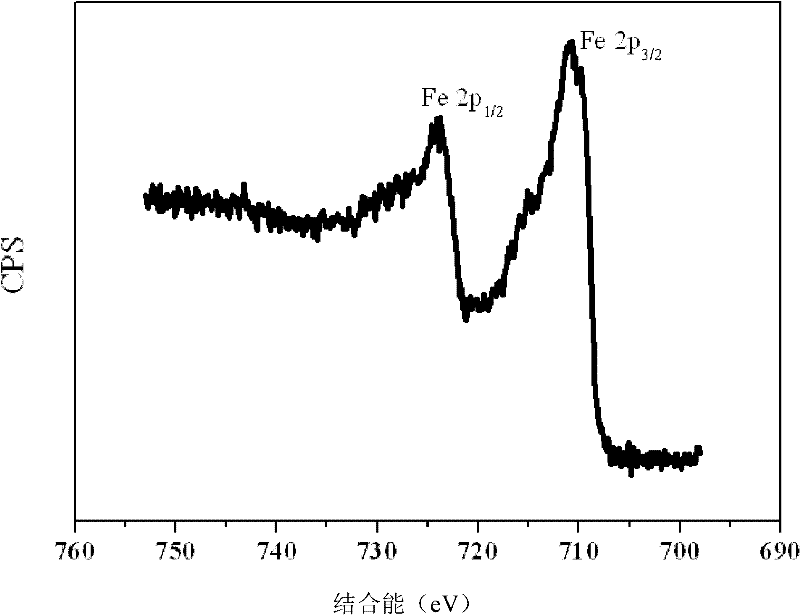Preparation method of polyanion cathode material of lithium ion battery
A technology for lithium-ion batteries and positive electrode materials, applied in battery electrodes, circuits, electrical components, etc., can solve the problems of daily ion disorder, high-temperature capacity decline, and high price, and achieve stability and batch consistency. Avoid falling, suppress the effect of impurity
- Summary
- Abstract
- Description
- Claims
- Application Information
AI Technical Summary
Problems solved by technology
Method used
Image
Examples
Embodiment 1
[0024] Add 1 mol of lithium dihydrogen phosphate, 0.5 mol of ferric oxide, and 30 g of glucose into 250 ml of water, use a nitrogen-filled grinder to mix the raw materials evenly, and use a closed nitrogen-protected spray drying equipment to dry the slurry to obtain a precursor powder , and then the precursor powder was sintered at 700°C for 16h in a box furnace with a nitrogen atmosphere, and then pulverized in a jet mill with an atmosphere protection to obtain lithium iron phosphate (LiFePO 4 )Material.
[0025] Then, lithium iron phosphate was used as the positive electrode material of lithium ion battery to make a simulated battery, and the battery performance test was carried out. First, the active material, PVDF and Super-P are dispersed in N-methylpyrrolidone (NMP) at a mass ratio of 85:10:5 to make a slurry, and then the slurry is coated on An electrode sheet is formed on the aluminum foil, and the electrode sheet is dried in a vacuum oven at 110° C. for 12 hours. Pu...
Embodiment 2
[0029] Add 1mol of lithium dihydrogen phosphate, 1mol of ferrous oxalate, and 25g of citric acid into 250ml of water, use a nitrogen-filled grinder to mix the raw materials evenly, and use a closed nitrogen-protected spray drying equipment to dry the slurry to obtain the precursor powder. The precursor powder is continuously passed through N 2 / H 2 (95:5) sintered at 720°C for 16h in a box-type furnace with a mixed atmosphere, and then pulverized in a jet mill equipped with nitrogen protection to obtain lithium iron phosphate (LiFePO 4 )Material. Other experimental steps and testing steps are the same as in Example 1.
[0030] Tests on battery performance found that the 0.1C discharge capacity of lithium iron phosphate material reached 155mAh / g.
Embodiment 3
[0032] Add 1mol of lithium hydroxide, 1mol of iron phosphate, and 28g of carbon gel into 250ml of water, stir the raw materials evenly with a grinder that can be filled with nitrogen, and dry the slurry with a closed nitrogen-protected spray drying equipment to obtain the precursor powder. The precursor powder was sintered at 700 °C for 16 hours in a box furnace with an Ar atmosphere, and then pulverized in a jet mill with nitrogen protection to obtain lithium iron phosphate (LiFePO4) with a D50 particle size of 3-6 μm. 4 )Material. Other experimental steps and testing steps are the same as in Example 1.
[0033] Tests on battery performance found that the 0.1C discharge capacity of lithium iron phosphate material reached 153mAh / g.
PUM
| Property | Measurement | Unit |
|---|---|---|
| particle diameter | aaaaa | aaaaa |
| particle diameter | aaaaa | aaaaa |
Abstract
Description
Claims
Application Information
 Login to View More
Login to View More - R&D
- Intellectual Property
- Life Sciences
- Materials
- Tech Scout
- Unparalleled Data Quality
- Higher Quality Content
- 60% Fewer Hallucinations
Browse by: Latest US Patents, China's latest patents, Technical Efficacy Thesaurus, Application Domain, Technology Topic, Popular Technical Reports.
© 2025 PatSnap. All rights reserved.Legal|Privacy policy|Modern Slavery Act Transparency Statement|Sitemap|About US| Contact US: help@patsnap.com

